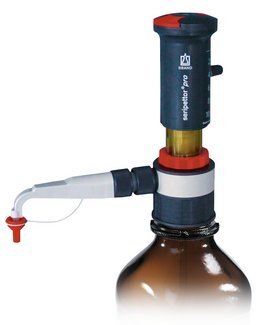Functional principle of bottle-top dispensers
By an upward movement of the piston, the preset amount of liquid is aspirated from the reagent bottle into the dispenser cylinder. By the subsequent downward movement of the piston, the liquid is released through a valve system and the discharge tube. There is no need to set a meniscus or to observe a waiting time.
Bottle-top dispensers with floating pistons
Dispensette® from BRAND

For dispensing aggressive reagents, e.g., concentrated acids such as H3PO4, H2SO4, bases like NaOH, KOH, saline solutions, as well as many organic solvents: Dispensette® S

For dispensing organic solvents, such as chlorinated and fluorinated hydrocarbons (e.g., trichlorotrifluoroethane and dichloromethane), or acids such as concentrated HCl and HNO3, as well as for trifluoroacetic acid (TFA), tetrahydrofuran (THF) and peroxides: Dispensette® S Organic

For dispensing HF we recommend the use of the Dispensette® S Trace Analysis with a platinum-iridium valve spring.
Bottle-top dispensers with wiping-seal piston
seripettor® from BRAND
The design of the system allows a replacement of the complete dispensing cartridge. The somewhat higher operating forces dur-ing filling are minimized by a spring with automatic lifting action. The present example reflects a competitively-priced dispenser for simple dispensing tasks in the volume range of 0.2 to 25 ml.
Range of application and materials
The range of application in-cludes the daily routine dispens-ing of bases, acids in low con-centration, biological buffers, cell culture media, biological detergents and polar solvents.
The seripettor® pro dispenser is suitable for dispensing acids such as concentrated HCl, po-lar solvents (e.g., acetone) and UV-sensitive media. In contrast to the seripettor® dispenser, valves made from chemically resistant materials are used in this instrument.
Documents download
Documents download
Safety always comes first!
When choosing a bottle-top dispenser, the safety features of the instrument should be kept in mind. For example, does it reduce the risk of injury due to glass breakage? How does it avoid accidental splashing when the instrument is primed? How is contact with the medium minimized when the dispensing tube is closed? Likewise, the suitability of the dispenser for the medium to be dispensed should be checked by the user. Information about this can generally be found in the operating manual in the chapter 'Function and limitations of use'. When in doubt, contact the manufacturer directly. Information on maintenance and monitoring of measuring instruments are also found in the operating manual.







